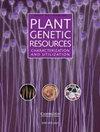流行的阿尔及利亚大麦地方品种Saïda和Tichedrett是本地大麦- RAPD, SSR和农业物候标记的证据
IF 0.7
4区 生物学
Q3 PLANT SCIENCES
Plant Genetic Resources: Characterization and Utilization
Pub Date : 2022-12-01
DOI:10.1017/S1479262123000291
引用次数: 0
摘要
来自北非的传统大麦品种的特征在检测与抗旱能力相关的性状方面是有希望的。采用随机扩增多态性DNA (RAPD)和SSR (Simple Sequence Repeat)标记对阿尔及利亚9个地方大麦品种Saïda183和Tichedrett进行基因分型,以了解它们的系统发育关系,并比较两种方法的效率。选择的SSR标记使大麦的所有染色体至少有一个标记。此外,还进行了形态农艺性状的主成分分析(PCA)。结果表明,基于RAPD标记的系统发育反映了供试品种的地理分布,而基于SSR标记的系统发育反映了供试品种的谱系。在RAPD标记中,BY14的多态性信息量最大,为0.82;SSR标记中,Bmg13的多态性信息量最大,为0.60。利用相似性矩阵构建系统发育树,推断出Fouara和Oued-Athmania亲缘关系密切(基于RAPD标记的Jaccard Index为0.8)。SSR标记将本土品种Saïda183和Tichedrett归为一类,Jaccard指数为0.8。形态学和农艺性状的主成分分析也支持Saïda183与Tichedrett之间密切的系统发育关系。我们的数据支持阿尔及利亚大麦品种的多样性,并为这两个阿尔及利亚地方品种的本土起源提供支持。本文章由计算机程序翻译,如有差异,请以英文原文为准。
The popular Algerian barley landraces Saïda and Tichedrett are autochthonous – evidence from RAPD, SSR and agrophenological markers
Abstract The characterisation of traditional barley varieties from North Africa is promising with respect to detect traits linked with resilience to drought. Nine Algerian barley varieties comprising the economically relevant local landraces Saïda183 and Tichedrett were genotyped by random amplifying polymorphic DNA (RAPD) and by Simple Sequence Repeat (SSR) markers to get insight into their phylogenetic relationship and to compare the efficiency of the two approaches. The SSR markers were chosen such that all chromosomes of barley were represented by at least one marker. In addition, a principal component analysis (PCA) of morpho-agronomical traits was conducted. We found that the phylogeny based on the RAPD markers reflected the geographical distribution of the tested varieties, while the phylogeny based on the SSR markers reflected the pedigree. Among the RAPD markers, the maximal polymorphism information content was obtained for BY14 with a value of 0.82, for the SSR markers, Bmg13 was most informative with a value of 0.60. The similarity matrix used to the construct the phylogenetic tree, inferred a close relationship (Jaccard Index 0.8 based on RAPD markers) between the accessions Fouara and Oued-Athmania occurring in close vicinity. The SSR markers group the autochthonous varieties Saïda183 and Tichedrett together with a Jaccard Index of 0.8. The close phylogenetic relationship between Saïda183 and Tichedrett is also supported by the PCA of morphological and agronomic traits. Our data underpin the diversity of Algerian barley varieties and lend support to the autochthonous origin of these two Algerian landraces.
求助全文
通过发布文献求助,成功后即可免费获取论文全文。
去求助
来源期刊

Plant Genetic Resources: Characterization and Utilization
Agricultural and Biological Sciences-Agronomy and Crop Science
CiteScore
2.80
自引率
0.00%
发文量
29
审稿时长
>12 weeks
期刊介绍:
Plant Genetic Resources is an international journal which provides a forum for describing the application of novel genomic technologies, as well as their integration with established techniques, towards the understanding of the genetic variation captured in both in situ and ex situ collections of crop and non-crop plants; and for the airing of wider issues relevant to plant germplasm conservation and utilisation. We particularly welcome multi-disciplinary approaches that incorporate both a technical and a socio-economic focus. Technical aspects can cover developments in technologies of potential or demonstrated relevance to the analysis of variation and diversity at the phenotypic and genotypic levels.
 求助内容:
求助内容: 应助结果提醒方式:
应助结果提醒方式:


